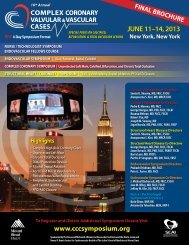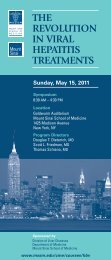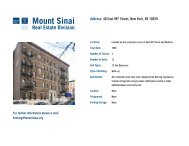March 19 - April 1, 2012 [PDF] - Mount Sinai Hospital
March 19 - April 1, 2012 [PDF] - Mount Sinai Hospital
March 19 - April 1, 2012 [PDF] - Mount Sinai Hospital
- No tags were found...
Create successful ePaper yourself
Turn your PDF publications into a flip-book with our unique Google optimized e-Paper software.
<strong>March</strong> <strong>19</strong> – <strong>April</strong> 1, <strong>2012</strong>inside<strong>Mount</strong> <strong>Sinai</strong>Scott L. Friedman, MD,New Dean for Therapeutic DiscoveryScott L. Friedman, MD, Fishberg Professor of Medicineand Chief, Division of Liver Diseases at The <strong>Mount</strong> <strong>Sinai</strong>Medical Center, has been appointed Dean for TherapeuticDiscovery, a new position that underscores <strong>Mount</strong> <strong>Sinai</strong>’semerging role in the development of novel drugs anddiagnostic products.In his new position, Dr. Friedman will work closely withthe Office of Technology and Business Development, theExperimental Therapeutics Institute, and with researchersthroughout the institution to implement strategies toenhance therapeutic discovery, and identify moleculesthat can be commercialized through collaborations withbiotechnology and pharmaceutical companies.“Dr. Friedman is the ideal person to shepherd <strong>Mount</strong><strong>Sinai</strong> into a new phase of innovation, with bench-tobedsidemedical discoveries that may result in highimpacttherapeutic products,” says Dennis S. Charney, MD,Anne and Joel Ehrenkranz Dean of <strong>Mount</strong> <strong>Sinai</strong> Schoolof Medicine and Executive Vice President for AcademicAffairs, The <strong>Mount</strong> <strong>Sinai</strong> Medical Center.Scott L. Friedman, MD, will help <strong>Mount</strong> <strong>Sinai</strong> move into a new phaseof innovation and therapeutic discovery.CONTINUED ON PAGE 3<strong>Mount</strong> <strong>Sinai</strong> Signs Commercialization AgreementLookinsideDavid H. Koch Donates$10 Million to JaffeFood Allergy Institute26th Annual Valentine’sReunion PartyDonate Life Month<strong>Mount</strong> <strong>Sinai</strong> Cath LabNumber One For PCIThe <strong>Mount</strong> <strong>Sinai</strong> Medical Center has agreed to collaborate with MRC Technology,the licensing arm of the United Kingdom’s prestigious Medical Research Council,on the development of monoclonal antibodies that can be commercializedas drugs to control infection and treat diseases. The agreement calls for MRCTechnology to humanize mouse antibodies that are created by <strong>Mount</strong> <strong>Sinai</strong>’sCenter for Therapeutic Antibody Discovery (CTAD). Through humanization, amouse antibody’s molecular structure is altered without changing its bindingspecificity to make it compatible for therapeutic use in humans.<strong>Mount</strong> <strong>Sinai</strong>, one of the largest creators of mouse antibodies in the New Yorkmetropolitan area, will license the humanized antibodies to drugmakers throughits Office of Technology and Business Development (OTBD). The two-yearagreement with MRC Technology marks the first time <strong>Mount</strong> <strong>Sinai</strong> has entered intoa collaboration of this kind.With its expertise in utilizing mouse models, and culture of translational science,<strong>Mount</strong> <strong>Sinai</strong> can identify unmet medical needs and target these areas forCONTINUED ON PAGE 2Thomas Moran, PhD, Directorof <strong>Mount</strong> <strong>Sinai</strong>’s Centerfor Therapeutic AntibodyDiscovery
David H. Koch Donates $10 Million to Jaffe Food Allergy Instituterecruitment of leading scientists will helpestablish a robust team dedicated to foodallergy therapeutics. Mr. Koch is ExecutiveVice President of Koch Industries, and aKenneth L. Davis, MD, President and ChiefExecutive Officer of The <strong>Mount</strong> <strong>Sinai</strong> MedicalCenter, says, “Breakthrough therapeutics suchas these will change the face of children’sMy hope is that in the not-too-distant future,children who suffer from life-threatening foodallergies will have their lives transformed from thetherapies that originated here.— David H. KochDavid H. KochPhilanthropist David H. Koch recentlydonated $10 million to the Jaffe FoodAllergy Institute at The <strong>Mount</strong> <strong>Sinai</strong> MedicalCenter, to create the David H. and JuliaKoch Research Program in Food AllergyTherapeutics. The program will serve as a hubfor drug discovery related to food allergies,and build upon the promising work alreadyunder way at <strong>Mount</strong> <strong>Sinai</strong>. The additionalmajor advocate for medical research. The giftrepresents one of the largest donations evermade to the Jaffe Food Allergy Institute.Hugh A. Sampson, MD, Kurt HirschhornProfessor of Pediatrics, Dean for TranslationalBiomedical Research, and Director of theJaffe Food Allergy Institute, says Mr. Koch’sgift strengthens <strong>Mount</strong> <strong>Sinai</strong>’s position as aglobal leader in food allergy therapeutics.“Right now, the only recourse for patientswho have food allergies is to avoid thosefoods,” says Dr. Sampson. “This program hasthe potential to deliver the first therapies andcures for food allergy.”health. Mr. Koch’s visionary philanthropybrings us one step closer to that goal.”According to Mr. Koch, future therapies cansignificantly improve children’s lives. “This isan exhilarating time for science and medicinein food allergy, and Dr. Sampson and histeam are the best at what they do. But themost exciting discoveries are yet to come,”Mr. Koch says. “My hope is that in the nottoo-distantfuture, children who suffer fromlife-threatening food allergies will have theirlives transformed from the therapies thatoriginated here.”<strong>Mount</strong> <strong>Sinai</strong> Signs Commercialization Agreement (continued from page 1)treatment. MRC has expertise in humanization, and a vast networkof industrial contacts. The company’s portfolio of humanizedmonoclonal antibodies includes the drugs Tysabri ® , marketed byBiogen Idec Inc. for patients with multiple sclerosis, and Actemra ® ,marketed by Roche Pharmaceuticals, for patients withrheumatoid arthritis.To date, the collaboration between <strong>Mount</strong> <strong>Sinai</strong> and MRC centerson monoclonal antibodies that can be used to control infections,and treat drug addiction and autoimmune disease.Moran. “We want to encourage clinical and basic scientists toidentify unmet medical needs in their individual areas of expertise,and work with us to identify potential targets and developbiologics with therapeutic potential.”Humanized AntibodyMouse Derived CDRsCH1Mouse Derived CDRs<strong>Mount</strong> <strong>Sinai</strong> recently created an entity called Blue <strong>Mount</strong>ainTechnologies, led by Assistant Director and General ManagerFelipe Araujo, PhD, MBA, which explores commercializationoptions for monoclonal antibodies and other tangible assets,including molecular diagnostic reagents. CTAD, led by DirectorThomas Moran, PhD, and Blue <strong>Mount</strong>ain are currently assemblinga formal catalog with information on each of <strong>Mount</strong> <strong>Sinai</strong>’smonoclonal antibodies.VkCkHuman Light Chain}BindingVHHuman Heavy ChainSurface“MRC’s recognition of Dr. Moran’s and <strong>Mount</strong> <strong>Sinai</strong>’s antibodywork, and the enhanced commercialization capabilities of Dr.Araujo, put us in a stronger position to impact development ofnew therapies, diagnostics, and biomedical research reagents,”says Teri F. Willey, Vice President, Office of Technology andBusiness Development.Dr. Moran encourages <strong>Mount</strong> <strong>Sinai</strong> researchers to bring him theirideas. “<strong>Mount</strong> <strong>Sinai</strong> is strong in early science and research, andwe can see things that aren’t in the public domain yet,” says Dr.Humanized Antibody(single arm)Molecular graphic images produced by UCSF ChimeraA snapshot of a humanized antibody shows the complementarydetermining regions (CDRs) that have been taken from a mouseantibody (red loops), and grafted into the framework of a humanantibody (in green and blue).
Scott L. Friedman, MD, New Dean for Therapeutic Discovery (continued from page 1)“The creativity of <strong>Mount</strong> <strong>Sinai</strong>’s physicians and scientists, combinedwith the unique capabilities of the pharmaceutical and device industry,will result in the discovery of important new therapies for seriousmedical diseases.”As the cost of developing a new drug continues to rise—it is estimatedto be upward of $1 billion—companies will increasingly look to<strong>Mount</strong> <strong>Sinai</strong> and other top research institutions to provide concretescientific advances.“<strong>Mount</strong> <strong>Sinai</strong> is uniquely positioned as a translational academic centerthat provides outstanding patient care, and generates discoveriesthat are of great interest to the pharmaceutical industry,” says Dr.Friedman. “We have a lean, integrated structure that is responsiveto the rapidly changing world of drug discovery and development.”As Dean, Dr. Friedman says he will introduce <strong>Mount</strong> <strong>Sinai</strong> to a widearray of companies that are eager to invest in the intellectual propertydeveloped here.An internationally renowned physician-scientist, Dr. Friedman holdseight patents and serves as a consultant to more than 40 companiesin the field of liver fibrosis. He will continue to serve as Chief of theDivision of Liver Diseases in the Department of Medicine, a positionhe has held since 2001. Under his leadership, the division hasgrown into the largest liver medicine program in the United States,incorporating the largest clinical liver fellowship training program inthe country, a postdoctoral fellowship training grant supported by theNational Institutes of Health (NIH), and an Alcohol Research Centerfocused on fibrosis that is supported by the National Institute onAlcohol Abuse and Alcoholism.The division conducts international clinical trials of novel hepatitistreatments, and collaborates on an enormous national clinical andinvestigative liver cancer program, which incorporates groundbreakingclinical trials and NIH-sponsored basic/translational research.26th Annual Valentine’s Reunion PartyThe Annenberg West lobby was adornedwith cartoon cut-outs and balloons for the26th Annual Valentine’s Reunion Party thatbrought together several hundred pediatricheart patients and their families with <strong>Mount</strong><strong>Sinai</strong> physicians and staff. Wearing shiny hatsin the shape of glittering crowns, and paintedred hearts on their cheeks, the childrenate frosted cupcakes, played games, andcelebrated their improved health. The childrenalso posed for pictures with Miss USA AlyssaCampanella, Miss Teen USA Danielle Doty, andtelevision actor Matthew Settle.The party was hosted by the Division ofPediatric Cardiology, the Department ofCardiothoracic Surgery, the Children’s HeartFund—an organization established by parentsof pediatric patients at <strong>Mount</strong> <strong>Sinai</strong>—andProject Sunshine, a nonprofit organizationthat helps children and families living withmedical challenges.Ira A. Parness, MD, Professor of Pediatrics andChief of the Division of Pediatric Cardiology,told guests, “This Valentine’s reunion dayreminds us to celebrate the purpose of ourtherapy as we watch the children playingjoyously outside of the clinic environment.This is our greatest reward.”One of the participants was heart transplantpatient Donald Redfield, 26, from Poughkeepsie,This Valentine’s reunion day reminds us to celebrate thepurpose of our therapy as we watch the children playingjoyously outside of the clinic environment. This is ourgreatest reward.— ira A. parness, MDN.Y., who has attended five reunions. He firstcame to The <strong>Mount</strong> <strong>Sinai</strong> Medical Center in<strong>19</strong>98, when he was 12 years old, to receivetreatment for dilated cardiomyopathy, adisease of the heart muscle. “It’s great to seeall the doctors, nurses, and echo-technicianswho have taken care of you over the years,”said Mr. Redfield, who is now an adult patientat <strong>Mount</strong> <strong>Sinai</strong> Heart.Dr. Parness acknowledged staff, amongthem EKG Supervisor Robbin Berry,who every year oversees a large team ofvolunteers responsible for creating andpainting hundreds of cartoon cut-outs forthe party. He also thanked Project Sunshineand Aileen Janover, a member of the <strong>Mount</strong><strong>Sinai</strong> Auxiliary Board, who helped establishHeart-to-Heart clubs in 12 Manhattan highschools to enable students to interact withpatients at <strong>Mount</strong> <strong>Sinai</strong> Kravis Children’s<strong>Hospital</strong>. Approximately 50 of these studentsvolunteered to set up the event and work atthe booths.Said Rachel Justus, LCSW, about the annualreunion, “This is an incredible opportunityto celebrate life, and a wonderful way for<strong>Mount</strong> <strong>Sinai</strong> staff, and all volunteers, to cometogether and support these heroic families.”For more information, visitkravischildrenshospital.org.ABOVE: Even the tiniest patients came to the reunion party.Patient Mariana Gilbert, held by mother, Damaris, is thedaughter of Joseph Gilbert, MPH, National Children’s Study,Queens Vanguard Center, <strong>Mount</strong> <strong>Sinai</strong> School of Medicine.LEFT: Heart transplant patient Donald Redfield; Rica Arnon,MD, Associate Professor of Pediatrics; patient Natalie Bedid;patient Siobhan O’Shea; Ira A. Parness, MD; patient RachelHansson; and patient J.J. Mirkovic, Jr.
Events<strong>April</strong> Is Donate Life MonthIn honor of National Donate Life Month, The Recanati/Miller Transplantation Institute and New York Organ DonorNetwork will distribute educational material about theimportance of organ donation during the week of <strong>April</strong> 16.Health professionals are encouraged to attend the Passportto Life Program on <strong>April</strong> 17 to learn how they can participatein organ donation.Monday, <strong>April</strong> 16 – Friday, <strong>April</strong> 2010 am – 3 pmGuggenheim PavilionFriedman Brain InstituteTranslational NeuroscienceSeminar SeriesGeorge Koob, PhD, Professorand Chair, Committee on theNeurobiology of AddictiveDisorders, The ScrippsResearch Institute, presents“Neurocircuitry of Addiction:View from the Dark Side.”Thursday, <strong>March</strong> 221 pmIcahn Medical InstituteFirst Floor Seminar RoomTuesday, <strong>April</strong> 1710 am – 3 pmAnnenberg, West LobbyGrand RoundsPediatricsRichard Insel, MD, ChiefScientific Officer, JuvenileDiabetes Research Foundation,presents “Type 1 Diabetes:Progress Toward Prevention,Treatment, and Care.”Thursday, <strong>March</strong> 298 – 9 amHatch AuditoriumGrand RoundsObstetrics, Gynecologyand Reproductive ScienceChyong-Huey Lai, MD, Director,Gynecologic Cancer Researchand Clinical Trial Centers, ChangGung Memorial <strong>Hospital</strong>, Taiwan,presents “Molecular Imaging onGynecologic Malignancies.”Wednesday, <strong>March</strong> 218 – 9 amGoldwurm AuditoriumDevelopmental andRegenerative BiologySeminar SeriesMarc Tessier-Lavigne, PhD,President and Professor,Laboratory of Brain DevelopmentRepair, The Rockefeller University,presents “Wiring the Brain:Combinatorial Control of AxonGuidance.”Thursday, <strong>March</strong> 29Noon – 1 pmAnnenberg 25-51Conference Room<strong>Mount</strong> <strong>Sinai</strong> Cath Lab Number OneFor PCI in New York StateJoint CommissionSurvey PreparationThe safety of patients and employees is<strong>Mount</strong> <strong>Sinai</strong>’s highest priority. In preparationfor the upcoming hospital-wide surveyby the Joint Commission, an organizationthat accredits and certifies health careorganizations and programs in the UnitedStates and sets performance standards,employees are asked to ensure a safeenvironment by taking these steps:• Wear your <strong>Mount</strong> <strong>Sinai</strong> ID visiblyabove the waist at all times;• Keep hallways free of clutter;• Review and know location ofred emergency guides;• Call 4FIRE and follow RACE(Rescue, Alarm, Confine,Extinguish) in case of a fire;• Remove expired items from refrigeratorsand maintain temperature logs;• Access Materials Safety Data Sheets(MSDS) by calling 800-451-8346 orvisiting www.msds.com (username:mssm, password: msds);• Identify patients correctly byname and date of birth;• Avoid use of unapproved abbreviations;• Get important patient test results (criticalvalues) to the right staff person on time;• Label, check expiration, andreconcile all medications;• Practice effective handoff communication;• Always perform hand hygiene;• Pause (time out) before surgery;• Protect private patient information;• Document all patient careinterventions in the care plan;• Document multidisciplinary involvementin patient and family education.The <strong>Mount</strong> <strong>Sinai</strong> Medical Center’s CardiacCatheterization Laboratory again has achievedthe highest “two-star” safety rating among54 New York State institutions that performpercutaneous coronary intervention (PCI)in two categories: overall cases, and nonemergencycases. This is according to a reportreleased in <strong>March</strong> by the New York StateDepartment of Health that examined patientdischarges from 2007–2009. PCI is a minimallyinvasive procedure used to treat patients withdiseased or blocked coronary arteries.The Lab achieved these results while alsoperforming the highest number of PCIprocedures in the state—5,060 in 2009, and13,993 for the entire three-year period from2007 to 2009. The two-star safety rating isrisk-adjusted to account for the varying level ofdifficulty involved in treating each patient. Assuch, to earn this designation, a cardiac centerhas to accept difficult cases and completethem with virtually no complications.“We have shown that teamwork and adherenceto meticulous standardized medical protocolscan drive complication rates to their minimum,and this is evident by the safety rating we haveachieved for the last 15 years,” says Samin K.Sharma, MD, <strong>Mount</strong> <strong>Sinai</strong>’s Director of ClinicalCardiology.Valentin Fuster, MD, PhD, Physician-in-Chiefof The <strong>Mount</strong> <strong>Sinai</strong> Medical Center, andDirector of <strong>Mount</strong> <strong>Sinai</strong> Heart, the Zena andMichael A. Wiener Cardiovascular Institute,and the Marie-Josée and Henry R. KravisCenter for Cardiovascular Health, says, “Wehave a world-class team of interventionalistscapable of handling the most difficult cases.Our comprehensive outreach and educationprograms—and ever-expanding regionalaffiliate network—are also critical to the highqualitycare we deliver, and the improvedpatient outcomes we achieve.”Annapoorna Kini, MD, newly appointed Directorof the Cardiac Catheterization Laboratory,says, “Our strong leadership team encouragesopen communication and emphasizes constantincremental improvement in every area.”Inside <strong>Mount</strong> <strong>Sinai</strong><strong>2012</strong> Marketing & CommunicationsCarrie Gottlieb, EditorMarilyn Balamaci, EditorSubmissionsBox 1475inside@mssm.eduVisit Inside on the Webwww.mountsinai.org/insideTo find out what’s happeningright now, follow <strong>Mount</strong> <strong>Sinai</strong>on Twitter @<strong>Mount</strong><strong>Sinai</strong>NYCVisit us on Facebookfacebook.com/mountsinainyc


![March 19 - April 1, 2012 [PDF] - Mount Sinai Hospital](https://img.yumpu.com/48990923/1/500x640/march-19-april-1-2012-pdf-mount-sinai-hospital.jpg)
![December 2, 2012 [PDF] - Mount Sinai Hospital](https://img.yumpu.com/51092274/1/190x245/december-2-2012-pdf-mount-sinai-hospital.jpg?quality=85)
![January 21, 2013 [PDF] - Mount Sinai Hospital](https://img.yumpu.com/50916550/1/190x245/january-21-2013-pdf-mount-sinai-hospital.jpg?quality=85)
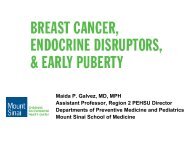
![February 3, 2013 [PDF] - Mount Sinai Hospital](https://img.yumpu.com/50584982/1/190x245/february-3-2013-pdf-mount-sinai-hospital.jpg?quality=85)
![March 18, 2012 [PDF] - Mount Sinai Hospital](https://img.yumpu.com/50462098/1/190x245/march-18-2012-pdf-mount-sinai-hospital.jpg?quality=85)
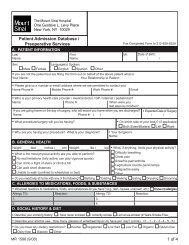
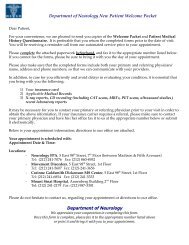
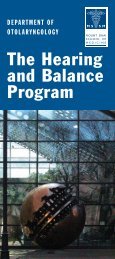
![Partners Program Guide [PDF] - Mount Sinai Hospital](https://img.yumpu.com/49411954/1/190x245/partners-program-guide-pdf-mount-sinai-hospital.jpg?quality=85)
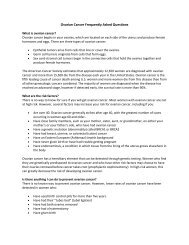
![PGY-1 Residency Application [PDF] - Mount Sinai Hospital](https://img.yumpu.com/48577701/1/190x245/pgy-1-residency-application-pdf-mount-sinai-hospital.jpg?quality=85)
